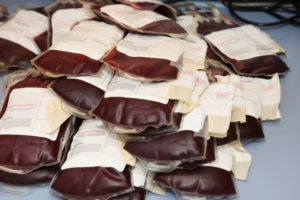AABB’s clinical practice guidelines recently stated that transfusion of fresh red blood cells (RBCs) compared to standard issue RBCs have similar clinical outcomes, but also stated there are questions about the last week of storage. RBCs may be stored up to 6 weeks (42 days). Rapido and colleagues transfused 60 healthy adult volunteers with one unit of autologous, leukoreduced, packed RBCs stored 1, 2, 3, 4, 5 or 6 weeks (n=10 per group). Transfusion of RBCs stored for progressively longer times were associated with increased extravascular hemolysis, decreased cell recovery, and increased hepcidin levels. Circulating nontransferrin-bound iron was observed in 10% (1/10) and 78% (7/9) of volunteers transfused with RBCs stored for 5 or 6 weeks, respectively (p=0.003), which may cause patients to be more susceptible to pathogenic infections or other adverse events. The maximum storage time of RBCs should continue to be evaluated in terms of safety, and cost and supply.
Reference:
- Lee JS, Kim-Shapiro DB. Stored blood: how old is too old? J Clin Invest 2016.
- Rapido F, Brittenham GM, Bandyopadhyay S, La Carpia F, L’Acqua C, McMahon DJ, Rebbaa A, Wojczyk BS, Netterwald J, Wang H, Schwartz J, Eisenberger A, Soffing M, Yeh R, Divgi C, Ginzburg YZ, Shaz BH, Sheth S, Francis RO, Spitalnik SL, Hod EA. Prolonged red cell storage before transfusion increases extravascular hemolysis. J Clin Invest 2016.

